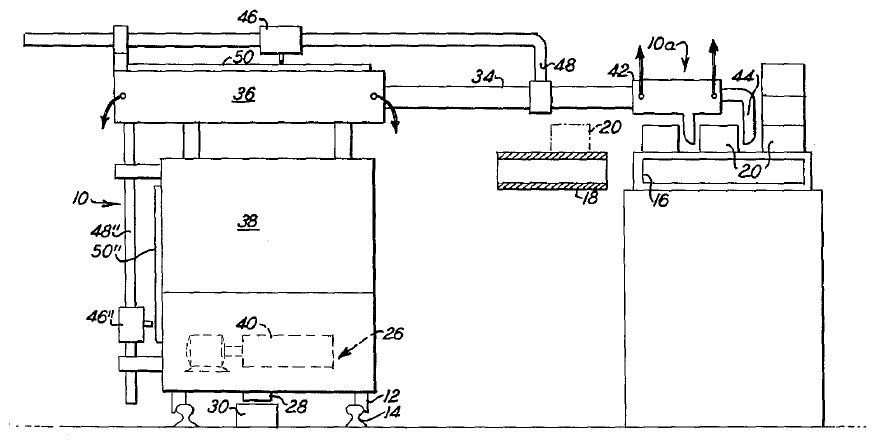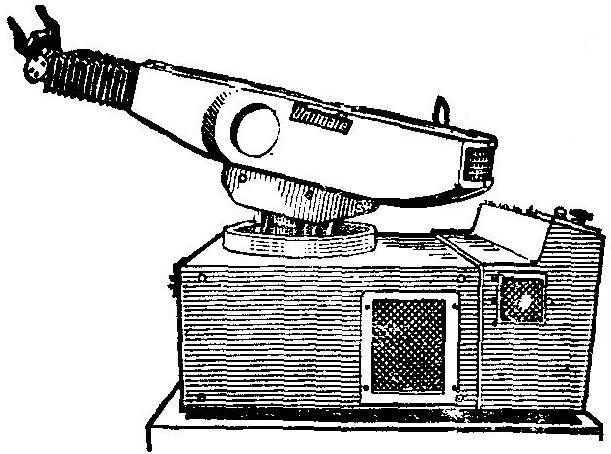Unimate was the first patented industrial robot, which worked on a General Motors assembly line at the Inland Fisher Guide Plant in Ewing Township, New Jersey, in 1961. It was created by George Devol in the 1950s using his original patent filed in 1954 and granted in 1961. George Devol, together with Joseph Engelberger, started the world’s first robot manufacturing company, Unimation, in 1956.[1][2][3]
Unimation robots were also called programmable transfer machines since their main use at first was to transfer objects from one point to another.[6] The machine undertook the job of transporting die castings from an assembly line and welding these parts on auto bodies, a dangerous task for workers, who might be poisoned by exhaust gas or lose a limb if they were not careful.[2]
Unimate had 5 degrees of mobility with a hydraulic drive and two-finger gripper with pneumatic actuator. The movement of objects weighing up to 12 kg was carried out with an accuracy of 1.25 mm. The carrier medium at view of cam drum with stepper motor, intended for 200 control commands, and position encoders were used as control system. In the training mode the operator assigned the sequence of points that links of the manipulator have to go through during the working cycle. Robot memorized the coordinates of points, and was able to move automatically from one point to another in a predetermined sequence, repeating the working cycle many times. At the unloading operation of machine for the injection molding, Unimate worked with a productivity of 135 parts per hour with 2% of waste, whereas the productivity of the manual unloading was 108 parts per hour with up to 20% of waste.[8]
Unimation licensed their technology to Kawasaki Heavy Industries and GKN, manufacturing Unimates in Japan and England respectively. For some time Unimation’s only competitor was Cincinnati Milacron Inc. of Ohio. This changed radically in the late 1970s when several big Japanese conglomerates began producing similar industrial robots.[6] In 2003 the Unimate was inducted into the Robot Hall of Fame.[2] In 2005, Popular Mechanics magazine selected Unimate as one of the Top 50 Inventions of the Past 50 Years.[3]
References:
1. Patent US2988237 – ORDER – Google Patents. – Mode of access: http://www.google.com/patents/US2988237.
2. Unimate. – Mode of access: http://en.wikipedia.org/wiki/Unimate.
3. George Devol. – Mode of access: http://en.wikipedia.org/wiki/George_Devol.
4. Joseph Engelberger. – Mode of access: http://en.wikipedia.org/wiki/Joseph_Engelberger.
5. Энгельбергер, Джозеф. – Mode of access: http://ru.wikipedia.org/wiki/%D0%AD%D0%BD%D0%B3%D0%B5%D0%BB%D1%8C%D0%B1%D0%B5%D1%80%D0%B3%D0%B5%D1%80,_%D0%94%D0%B6%D0%BE%D0%B7%D0%B5%D1%84.
6. Industrial robot. – Mode of access: http://en.wikipedia.org/wiki/Industrial_robot.
7. Промисловий робот. – Mode of access: http://uk.wikipedia.org/wiki/%D0%9F%D1%80%D0%BE%D0%BC%D0%B8%D1%81%D0%BB%D0%BE%D0%B2%D0%B8%D0%B9_%D1%80%D0%BE%D0%B1%D0%BE%D1%82.
8. Промышленный робот. – Mode of access: http://ru.wikipedia.org/wiki/%D0%9F%D1%80%D0%BE%D0%BC%D1%8B%D1%88%D0%BB%D0%B5%D0%BD%D0%BD%D1%8B%D0%B9_%D1%80%D0%BE%D0%B1%D0%BE%D1%82.
9. The Top 50 Inventions of the Past 50 Years – Popular Mechanics. – Mode of access: http://www.popularmechanics.com/technology/gadgets/news/2078467.
10. Robot Hall of Fame: Home. – Mode of access: http://etc.cmu.edu/projects/rhof/csc/index.htm.
11. Handbook of Industrial Robotics / ed. Shimon Y. Nof. – New York ; Chichester ; Brisbane ; Toronto ; Singapore : John Wiley & Sons, 1985. – 1358 p.
12. Robotics and Automation Handbook / ed. Thomas R. Kurfess. – Boca Raton ; London ; New York ; Washington : CRC Press LLC, 2005. – 580 p.
13. Springer Handbook of Automation / ed. Shimon Y. Nof. – Berlin ; Heidelberg : Springer, 2009. – 1812 p.
14. Козырев Ю.Г. Промышленные роботы: Справочник / Ю.Г. Козырев. – [2-е изд.]. – Москва : Машиностроение, 1988. – 392 с.
15. Спыну Г.А. Промышленные роботы. Конструирование и применение / Г.А. Спыну. – [2-е изд.]. – Киев : Выща школа, 1991. – 312 с.

